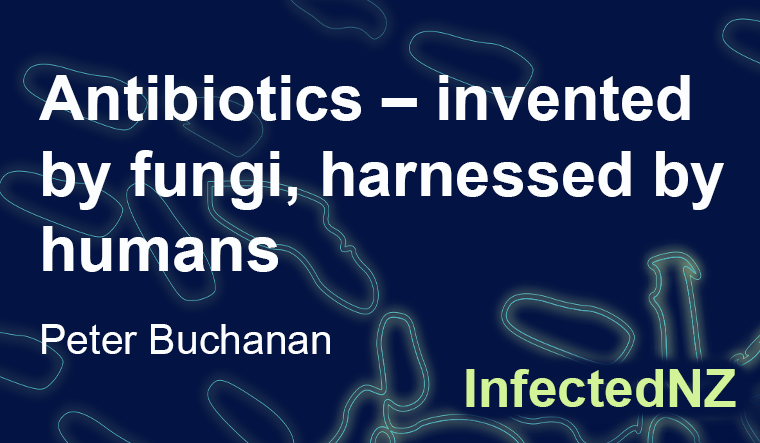The fungi are a vast and distinctive kingdom of organisms that make up a significant component of most land ecosystems, intimately linked with bacteria, plants, and animals. Fungi cannot make their own food, so they live on or within their food, be that dead wood or leaves, overmature fruit, or a living plant or animal. In these habitats, a fungus competes with other life forms including other fungi and also bacteria. Some species of fungi have adapted to growth in hostile habitats, while others developed biochemical defences to fight off competitors. The awareness and application of these fungal defences has revolutionised modern medicine.
The idea that a substance could be used as a ‘magic bullet’ to target disease causing organisms dates from the late 19th Century. In 1909 Nobel prize winner Paul Ehrlich and his team effectively began the science of drug discovery when they developed the organic arsenic compound Salvarsan to treat syphilis. But it wasn’t until the chance discovery of antibacterial action by fungi that antibiotics became one of humanity’s major medical advances.
Alexander Fleming is credited with the discovery and naming of penicillin. In 1928 he returned from holiday to St Mary’s Hospital, London, to find previously living cultures of the bacterium Staphylococcus aureus contaminated and killed by a mould fungus Penicillium notatum. Fleming kept the fungal culture but wasn’t able to purify and stabilise penicillin. This achievement was left to Florey, Chain & Heatley at Oxford University. Subsequent researchers in the UK and USA perfected the production by fermentation and later chemical synthesis, enabling a revolution in medical intervention to counter previously lethal conditions such as pneumonia, septicaemia, and gangrene. Before antibiotics, bacterial infection of a skin wound often led to growth of bacteria that overwhelmed the body’s immune system. In World War 1, for example, more than 1 in 10 soldiers injured in battle died of infected wounds.
The life-saving success of penicillin led to intensive research, especially until 1970, to discover new antimicrobial compounds produced by fungi and filamentous bacteria. This gave us antibiotics such as cephalosporin produced from Cephalosporium; neomycin, tetracycline and streptomycin (to initially control tuberculosis (TB)) from Streptomyces (Actinobacteria), and antifungals such as griseofulvin from Penicillium griseofulvin.
Since 1970, there have been very few new types of antibiotics discovered. At the same time, disease-causing bacteria have evolved to become resistant to our medicines, making currently available antibiotics less and less effective. Even worse, bacteria evolve antibiotic resistance much faster than the pace of new antibiotic discovery. Unfortunately, the major pharmaceutical companies have diverted research funds to more profitable drug development for chronic diseases rather than for bacterial infections. There’s an urgent need to develop new responses to overcome antibiotic-resistant superbugs, and so avoid a return to pre-penicillin days when an infected cut could be lethal.
This has been the motivation for a number of new research initiatives seeking novel antibiotics and other means to control bacterial infection. New Zealand’s national living culture collection of fungi and plant-associated bacteria is a research resource for national benefit, managed by Landcare Research. Bevan Weir, as Curator of the International Collection of Microorganisms from Plants (ICMP), is collaborating with Siouxsie Wiles and her University of Auckland postgraduate students seeking new antibiotic compounds from among the 20,000 cultures of fungi and bacteria. The New Zealand collection began in the 1950s, and includes many native species that have not previously been investigated for antibiotic production.
References
Livermore DM 2011. Discovery research: the scientific challenge of finding new antibiotics. J. Antimicrob. Chemother. 66: 1941–1944.
Moore D, Robson GD, Trinci PJ 2011. 21st Century Guidebook to Fungi. Cambridge University Press, Cambridge.
Overbye KM, Barrett JF 2005. Antibiotics: where did we go wrong? Drug Discovery Today 10: 45-52.
About
Peter Buchanan works for Landcare Research as Science Team Leader for a group of 30 science staff researching New Zealand’s most diverse groups of terrestrial organisms – the fungi, bacteria, invertebrates, and plants. Landcare Research is custodian of five national biological collections including the NZ Fungal Collection (PDD) and Culture Collection of Fungi and Bacteria (ICMP). Peter’s research interests are in fungal conservation, wood decay fungi, applied uses of fungi, and science education.
What is InfectedNZ?
Hey, Aotearoa. It’s time we had a chat about infectious diseases and what we’re going to do about the looming antimicrobial armageddon. That’s why we’ve asked leading health, social and economic researchers, and people with personal stories, to help us get real about our vulnerability and discuss solutions. Follow their blogs right here at tepunhahamatatini.ac.nz and watch the conversation spread across social media with #infectedNZ.
Backing it all up, wherever possible, is data from the good folk at Figure.NZ. Their super duper charts are based on data sourced from public repositories, government departments, academics and corporations. Check out their #infectedNZ data board and sign-up to create your very own data board on any topic that floats your boat.


